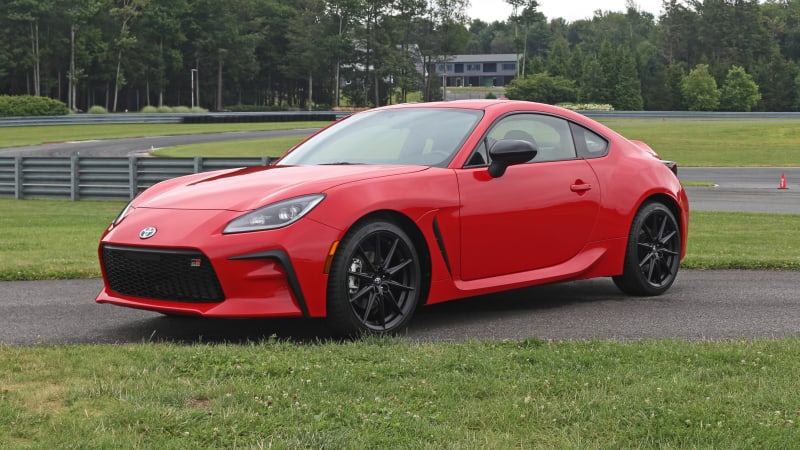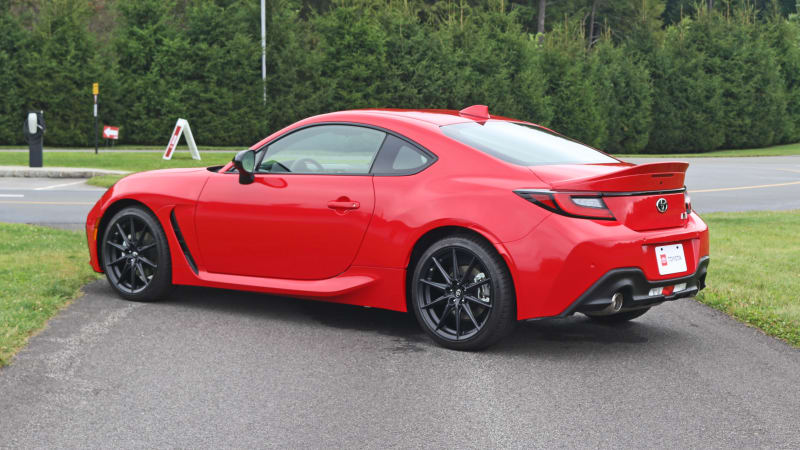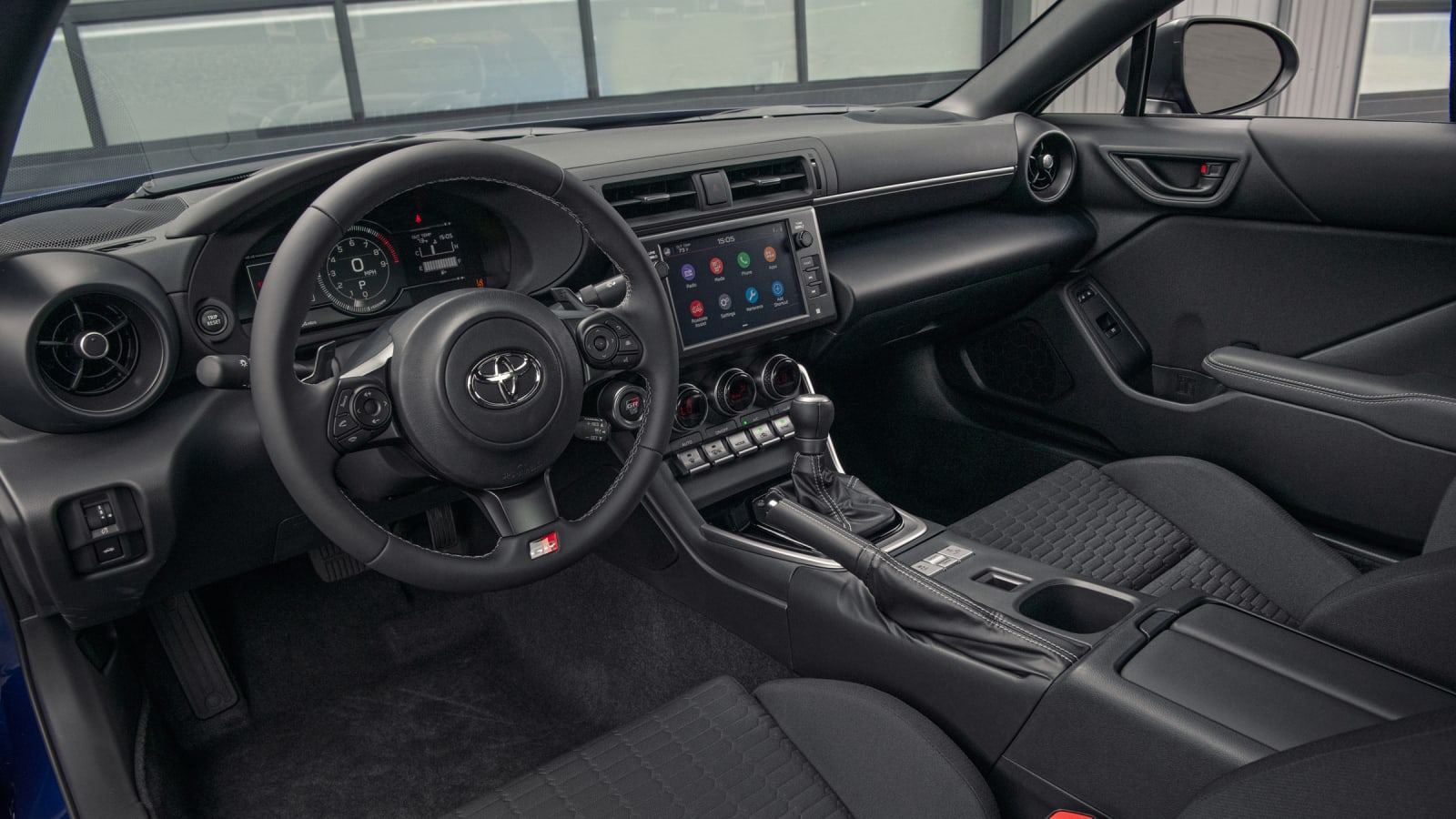MONTICELLO, N.Y. — It’s a story playing out all over the industry: When the time comes for a new generation, internal-combustion performance cars are being significantly overhauled rather than completely redesigned. The Nissan Z is going this route, and rumors have suggested a similar fate for the next-generation Ford Mustang. Even Cadillac’s Blackwing variants were really more akin to remixed versions of their predecessors than entirely new vehicles. And so it goes with the 2022 Toyota GR 86 (and its Subaru sibling, the BRZ, but that will have to wait a bit).
Toyota’s variant has now been blessed with the “GR” designation. That stands for Gazoo Racing, which started life as a Toyota skunkworks motorsports team. While it’s still the name for Toyota’s now-official factory racing efforts, the shorthand is also being used to denote models like the 86 and Supra that were built to be fun first and transportation second. So, not a Corolla.
Toyota’s marketing team has latched onto the new designation as an indicator that the little coupe has “graduated” to Toyota’s official performance division. That’s not the wildest pitch we’ve seen come toward the plate, but considering that the updates to the 2022 model were fairly modest, it’s not one we’re inclined to swing at.
The most noteworthy upgrade to the 2022 GR 86 is its engine. Out: a thrashy 2.0-liter boxer-four making 205 horsepower and (seemingly) about 9 pound-feet of torque. In: a more refined 2.4-liter mill that produces 228 horses and a peak of 184 lb-ft that arrives 2,700 rpm sooner than the old one (it was 156 lb-ft if you must know). Still around: six-speed manual and automatic gearboxes, both of which were tweaked to account for the new engine and improve quality of life.
The 2022 model is offered in two trims: Base and Premium. The former comes standard with 17-inch wheels and Michelin Primacy HP tires (yeah, the same ones originally and infamously referred to as “Prius tires”) in 215/45R17, while the Premium gets 18-inch wheels shod in the properly summer-spec Michelin Pilot Sport 4. Even this sticky rubber remains skinny from the factory, checking in at 215/40R18.
The GR 86’s wheelbase (101.4 inches), overall length (167.9 inches) and curb weight (2,811-2,868 pounds) are all near-as-makes-no-difference the same, too, thanks to the carry-over platform. The standard Torsen limited-slip differential also soldiers on, as does the MacPherson strut front suspension and multi-link rear. In short, the GR 86 is the same size and shape as the old 86, but slightly more powerful. With the manual, Toyota claims the 2022 GR 86 will hit 60 in 6.1 seconds on the way to a 140-mph top speed; the auto is a half a second slower and runs out of revs 6 mph sooner.
Second verse, same as the first, right? Well, that’s what Toyota was worried we’d say, so just to make it absolutely clear that the GR 86 is appreciably better than its predecessor, a few examples of the outgoing model were on-hand at the Monticello Motor Club in New York so that we could see (feel, really) for ourselves.
We started on Monticello’s South Course in the morning, allowing us to get acclimated to the cars on the shorter, slower configuration before we were turned loose on a modified version of the Full Course in the afternoon. I took my recon laps in a current-generation car to refamiliarize myself with its character and quirks while learning Monticello’s basic school line.
Stepping into the GR 86 afterward, the most immediate difference is just how less intrusive the 2.4-liter boxer-four is compared to its predecessor. It’s about as loud at wide-open throttle, but the old 2.0-liter’s gruffness has been largely smoothed over. There’s far less powertrain vibration in the steering wheel too, which is a welcome improvement.
Despite a 20% bump in both displacement and torque, the 2.4 actually feels a bit more free-revving too. We wouldn’t go so far as call it “eager” to climb the tach, but it’s nonetheless more willing to breathe near the top of the rev range. In fact, the difference is so pronounced that I found myself short-shifting on occasion after getting behind the wheel of the GR 86 after becoming re-acclimated to the outgoing car’s wheezier top end.
Speaking of shifting, one item that doesn’t seem significantly improved is the six-speed automatic. Frankly, this was never the gearbox to get in the FR-S/86/BRZ and that hasn’t changed. It’s a tangible drag on the car’s acceleration and it makes the GR 86 heavier and more lethargic. Meanwhile, the six-speed manual’s core gears (two, three and four – those you’re expected to shift between most often) had their throws adjusted to make it a bit easier to find what you want entirely by feel.
The chassis remains absolutely sublime, and the base model’s forgiving, low-grip tires continue to really help emphasize just how light on its feet the little 2+2 really is. Monticello’s Carousel – a long, decreasing-radius left-hander – invited us to swing the Primacy HPs back and forth across their traction peaks, transitioning seamlessly from under- to oversteer both progressively and predictably. They lack the outright grip of the Pilot Sport 4s, but they’re competent tires for any beginner looking to get a feel for a nimble, lightweight chassis.
Stepping up to the Premium gets you the larger, stickier tires at the expense of some approachability. They’re not transformative by any stretch of the imagination, but they’re certainly far less talkative. The extra grip never translated into a braking problem (stickier tires help your brakes work better at the expense of additional heat), but our sessions were brief and had no true flying laps, so it’s hard to say how well they’re likely to stand up to longer track outings. They should do just fine for a beginner’s autocross outing, however.
You’ll note that we didn’t discuss the 2.4-liter’s torque output up above in the engine chat, and that’s with good reason. While much was made of the 2.0-liter’s lack of grunt, its most vocal critics often focused specifically on its mid-range delivery, which was a bit lacking. Yeah, we’re talking about the “torque dip.” But here’s the thing: If you buy the 86 as a track or autocross toy, mid-range torque is the least of your concerns. If you find it mattering, you’re in the wrong gear. On the street, however, low- and mid-range torque delivery both matter a great deal, and the new GR 86 feels every bit as torquey as its improved figure suggests.
That said, the power delivery is basically the same. Peak torque hits a little lower (3,700 RPM), but plotted against the 2.0-liter’s torque curve, the shape is virtually identical – just raised a bit due to the higher output across the board. In other words, it drives about the same, it’s just a bit punchier across its rev range, making it more forgiving around town, especially in third and fourth gears, where the older car can easily be caught flat-footed. Even when I found myself short-shifting on track, that extra grunt was there to help mitigate my mistakes. It’s not a cure for poor gear selection, but it certainly helps.
And while we’re on the subject of new elements that make around-town driving more forgiving, the new 86 interior impresses immediately. The new, slightly less squared-off dash treatment is pretty easy on the eyes, and the factory seats are reasonably bolstered and sufficiently supportive. The cabin is still sparsely appointed, especially in the base model, where virtually everything is finished in a near-black monotone, but there are also some appreciable materials improvements here and there.
As for technology, the boxer engine isn’t the only thing Subaru obviously contributed. Although there’s a slight graphics reskin, the 86 features what is effectively Subaru’s StarLink touchscreen infotainment system. Even the surrounding physical buttons/knob selections are what you’d find in a Crosstrek, Forester, etc. This is actually good news for the 86, as Subaru’s tech is easier to use, quicker to respond and has better graphics than Toyota’s.
The various driver assistance tech also comes from Subaru, but only on cars with an automatic transmission. Automatic emergency braking, lane-departure warning and adaptive cruise control cannot be had with the manual. We can probably live with that.
At the risk of oversimplifying things, the 2022 Toyota GR 86 is the same, only better. It almost entirely retains the character that defined its predecessor while offering incremental improvement across the board. The rougher edges have been sanded down and the wick turned up a bit, but it’s still fundamentally the same car. That’s great news for fans of the formula, but probably not enough to sway those who’ve been demanding a turbo for nine years.
If you fall into that camp or were expecting a complete transformation, the 2022 GR 86 will leave you disappointed. If you appreciated the old car’s basic formula and just wanted a touch more outright speed, then you’re in luck. While it may not be perfect, the GR 86 ticks all the boxes for a fun, no-frills sport coupe with plenty of room for aftermarket augmentation.
We don’t have Toyota’s final pricing for the GR 86 yet, but we’re told it will start “comfortably” under $30,000 with destination included, meaning it remains affordable to boot. It may suffer from some of the same spec sheet weaknesses of its predecessor, but if you have to search that much to find a car’s flaws, I’d argue it never had any worth noting to begin with.




